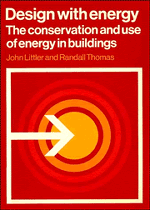Book contents
- Frontmatter
- Contents
- Units, symbols, abbreviations, conventions and conversion factors
- Preface
- 1 Energy and buildings
- 2 Site planning and analysis
- 3 Building design
- 4 Passive solar design
- 5 Active solar heating
- 6 Space heating and ventilation
- 7 Thermal storage
- 8 Wind energy
- 9 Water-supply systems
- 10 Waste disposal and utilization
- 11 Domestic-energy saving
- 12 Housing case studies
- 13 Non-domestic case studies
- Appendix 1 Weather data
- Appendix 2 Thermal performance
- Appendix 3 Interstitial condensation
- Index
8 - Wind energy
Published online by Cambridge University Press: 03 February 2010
- Frontmatter
- Contents
- Units, symbols, abbreviations, conventions and conversion factors
- Preface
- 1 Energy and buildings
- 2 Site planning and analysis
- 3 Building design
- 4 Passive solar design
- 5 Active solar heating
- 6 Space heating and ventilation
- 7 Thermal storage
- 8 Wind energy
- 9 Water-supply systems
- 10 Waste disposal and utilization
- 11 Domestic-energy saving
- 12 Housing case studies
- 13 Non-domestic case studies
- Appendix 1 Weather data
- Appendix 2 Thermal performance
- Appendix 3 Interstitial condensation
- Index
Summary
Introduction
In the wake of costs for wave power, which have exceeded original estimates, interest in the UK is tending to concentrate on wind power as a means of central electricity generation using renewable sources of energy. In such northern latitudes the use of concentrating solar collectors for power generation is not viable.
For this reason a consortium of companies in conjunction with the North of Scotland Hydroelectric Board is about to construct a 3 MW turbine in the Orkneys, illustrated in Fig. 8.1. There are also tentative plans to place large fields of vertical-axis turbines in shallow parts of the North Sea off the east coast of England. These turbines would be of the Musgrove type shown in Fig. 8.15. Studies show that up to 30% of electricity in use at a given time in the UK could be supplied from variable inputs such as wind turbines, without upsetting the grid network. Southern California Edison expects a 30% contribution by 1991.
However, this chapter seeks to deal with small, local wind turbines. It has to be pointed out that the energy derived from wind-power devices is not unending (the turbines probably should have a lifetime of 20 years or so in the absence of freak weather), is not free (the devices are quite large and thus costly) and that to some, the machines are not handsome, and to others, represent a hazard.
It may help to provide a brief checklist of advantages and problems presented by the home use of wind power, before embarking on a description of the energy and devices available.
- Type
- Chapter
- Information
- Design with EnergyThe Conservation and Use of Energy in Buildings, pp. 262 - 288Publisher: Cambridge University PressPrint publication year: 1984



